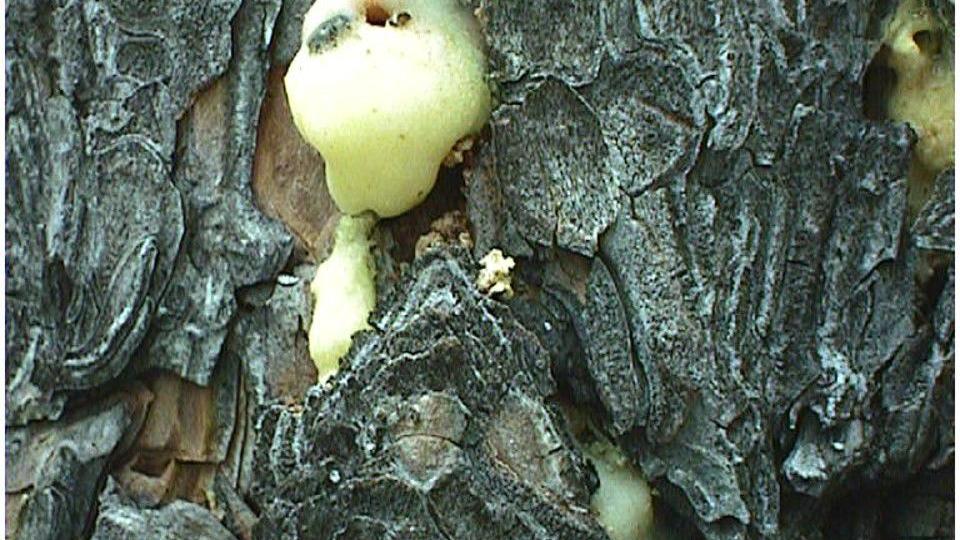The Oregon Department of Agriculture (ODA) places insect traps across the state in various rights of way, parks, neighborhoods, and businesses. The two most common invasive insect traps across the state are for Japanese beetles and gypsy moths. ODA invites the public to call (1-800-525-0137) or email (plant-entomologists@oda.state.or.us) with any questions. More information is available online at: https://oda.direct/TrappingSurveys.
Japanese beetle
In 2021, the Oregon Department of Agriculture (ODA) continues its multi-year effort to eradicate the Japanese beetle, an invasive and destructive insect pest, in the Portland, Beaverton, Cedar Mill and Lake Oswego areas. Thanks to the support and cooperation of those in the treatment area, we have succeeded in reducing the populations of Japanese beetles in Oregon. However, we still need the partnership of all community members to continue the fight against this pest.
The threat posed by the Japanese beetle that is establishing itself in Oregon cannot be overestimated as it is more than a nuisance and a garden pest. An economic analysis conducted by ODA concluded that it would cost farmers an estimated $ 43 million annually to control this pest, which will include increased use of pesticides. In addition, restrictions on agricultural exports would affect the marketability of Oregon’s crops and harm Oregon’s economy. Further information on the project can be found at www.JapaneseBeetlePDX.info.
Basic project introduction: oda.fyi/JBOpenHouseShort
Full video: oda.fyi/JBOpenHouse
For more frequently asked questions: www.japanesebeetlepdx.info/faq
Gypsy moth
The gypsy moth is an exotic, extremely destructive invasive species that has defoliated millions of acres of trees and shrubs in the northeastern United States. It is established in 19 states in the Northeast and threatens new states every year. Gypsy moths can spread quickly if not controlled and feed on hundreds of tree and shrub species. Preferred hosts include oak, apple, alder, hazelnut, willow, birch, madrone, poplar, and plum. With high populations, they also feed on firs and other types of coniferous wood. There are two similar looking species of gypsy moth threatening Oregon: European and Asian. The European female does not fly, the Asian female does. The Asian gypsy moth also has a broader range of hosts and likes to feed on pines and firs, which gives it the potential to spread rapidly in the Pacific Northwest.
Gypsy moths cause high economic, environmental and recreational costs as the population defoliates natural and urban areas. The defoliation of trees along streams can lead to higher water temperatures and increased pollution with organic material. The defoliation of areas affects the entire habitat. Fish and other aquatic organisms, as well as land plants and animals, can suffer from the damage they cause.
In 2020, ODA discovered an Asian gypsy moth on Sauvie Island and a European gypsy moth near Rainier. As a result, ODA plans to en masse these areas to see if we have an established population. In May 2019, ODA worked with the USDA and other federal and state agencies to treat an area of 45 acres in Corvallis, Benton County. Soil application of the biological pesticide Bacillus thuringiensis kurstaki appears to have wiped out the European gypsy moth population. Gypsy moths have not been detected in traps in Benton County since 2018, but we will continue our efforts to contain catches through 2021. Further information can be found at: https://oda.direct/GypsyMoth
Asian giant hornet
For possible sightings of Asian giant hornets (murder hornets) please report the details online. It is most helpful if you include pictures: https://oda.fyi/HornetReport.
Fortunately, no Asian giant hornets have been found in Oregon so far. However, there are some doppelgangers in our state. Please take a look at a poster created to illustrate some of the common Vespidae that have been submitted as suspicious Asian giant hornets: https://oda.direct/AGHlookalikes
Emma Eakins, a graduate of Glencoe High School and Eagle Scout (Troop 5615 Pacific Trail), helped ODA build traps for the early detection of the Asian giant hornet. Asian giant hornets were first spotted in Blaine, WA and British Columbia, Canada in 2019.
The Asian giant hornet is a serious pest for honeybees and its stings can cause severe reactions. The Washington Department of Agriculture created a trap scheme with empty two-liter bottles and a bait made from orange juice and rice cooking wine. In early 2021, Emma led a group of volunteers to collect 25 two-liter bottles and helped them build the traps.
Due to COVID-19 security precautions, Emma was unable to personally guide her volunteers. She overcame this limitation by creating care packages for her volunteers and working via video calling. They also made 80 bait vials, which require a precisely sized hole in a small Nalgene plastic vial to release a USDA-developed bait made from acetic acid and isobutanol at a steady rate. These traps will be set up in the field by ODA workers in the summer of 2021. If an Asian giant hornet is discovered, we will implement our Rapid Response Plan to eradicate it from the state.
In addition to building the insect traps, Emma trained several scout teams in the area about the dangers of invasive species, their impact on our environment, and what we can do to prevent invasive species from spreading. Emma’s work will help rid Oregon of the giant Asian hornet.
ODA values working with the community to help monitor invasive species and prevent them from harming our environment and agricultural raw materials.








